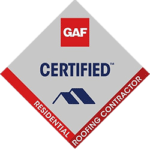
Why Are My Shingles Curling?
If your shingles are curling noticeably, it does not bode well for your roof’s future. If you have recently had your roof done, this is especially true.
“But why are my shingles curling if they are new?”
In truth, there are several reasons your shingles might be curling. But regardless of “why,” it’s probably a good idea to get them replaced as soon as possible.
Six Common Reasons Your Shingles Might Be Curling
1. Old Shingles
Of course, if you’ve recently had your roof replaced, age won’t be the issue. However, it is one of the most common reasons for curling shingles. If your roof is more than 15 years old, it’s time to think about a new roof. Shingles only have a certain lifespan. Once they’ve started to curl, they’re not going to get any better. If you notice your shingles failing, schedule your roof repair right away to prevent further damage.
2. Improper Installation
If you used an unlicensed contractor or one who doesn’t necessarily specialize in roofing, you could face issues from improper installation. An experienced roofing contractor knows the number of nails and what type to use. Believe it or not, the wrong kind of roofing nail could be the cause of your curling shingles.
Bottom line, be sure you partner with a reputable, licensed contractor who knows roofing! Failing to do so might void the warranty on your shingles, so be sure you’ve got that well in hand. A licensed contractor knows the optimum ambient temperature and weather conditions for roofing. They will also be sure to follow the shingle manufacturer’s installation instructions to the letter.
3. Inadequate Ventilation in Your Attic
Science tells us that hot air rises. That’s why your attic is the hottest spot in your house. If your attic is not well-ventilated, excess moisture pushes through to the exterior, and you will eventually see problems. It’s not unusual for shingles to curl or blister when there is inadequate attic ventilation. 
Proper roof ventilation means good air circulation. Your system should be pulling in outside air at the bottom of the roof and circulating it towards the top. When air does not circulate, heat and moisture are trapped. Excessive heat and humidity can cause many problems, and curling shingles is just one of them.
4. Shingles Not Lined Up On The Tar Line
Each shingle has a strip of tar on it. If the alignment is off, the adhesive won’t work as it should. The result of this is that your shingles might curl prematurely or fly off completely. Always work with a reputable licensed roofing contractor to ensure that your new shingles line up perfectly.
5. Inferior or Defective Shingles
Your shingles might curl if they are faulty from the start. Asphalt shingles are relatively inexpensive to manufacture, and there are plenty to choose from. What many people don’t realize is that there are several grades of asphalt. Some manufacturers will use cheaper grades so they can offer a lower-priced product.  While this might seem attractive to some homeowners, there are significant differences from one shingle to another.
While this might seem attractive to some homeowners, there are significant differences from one shingle to another.
If the asphalt is poor quality, the integrity of the shingles will break down. For example, while it’s normal for shingles to lose their ceramic granules, it’s not normal for them to start deteriorating halfway through their lifespan.
6. Shingles Installed Over Existing Shingles
Newer shingles installed over an existing layer tend to cause many problems. If your shingles are curling, this could be the cause. The new layer won’t line up over the old one, and it’s unlikely to seal adequately. Plus, any existing issues with the old roof – like mold, rotting, or broken shingles – will still be there.
Shingles are designed for installation on flat surfaces. Installing shingles over existing shingles impairs roof integrity. An extra layer of shingles also adds more weight, which could cause problems should you experience a lot of snow.
Lastly, when we tear off the old roof, we can inspect the sheathing and make necessary repairs. When shingles are installed over shingles, you just don’t know what’s underneath.
Other problems you might encounter with a second layer of shingles include:
- You can’t replace the bottom layer
- It might void your warranty
- Your roof might not be up to code
- Your roof might not pass an inspection
In conclusion, if your shingles are curling, you need the advice of a licensed roofing contractor right away. Call today to schedule a consultation









